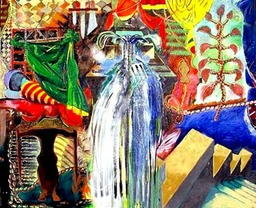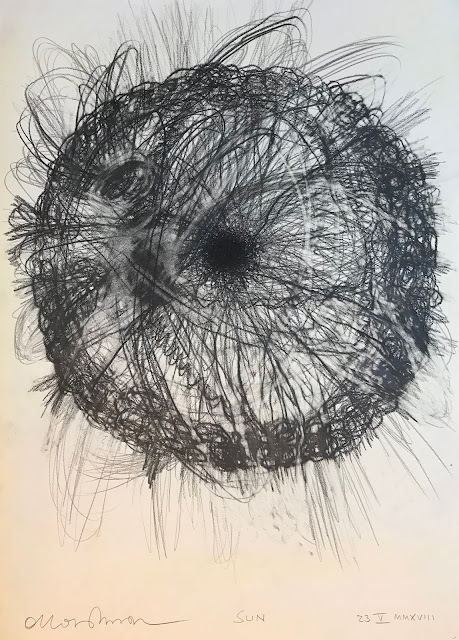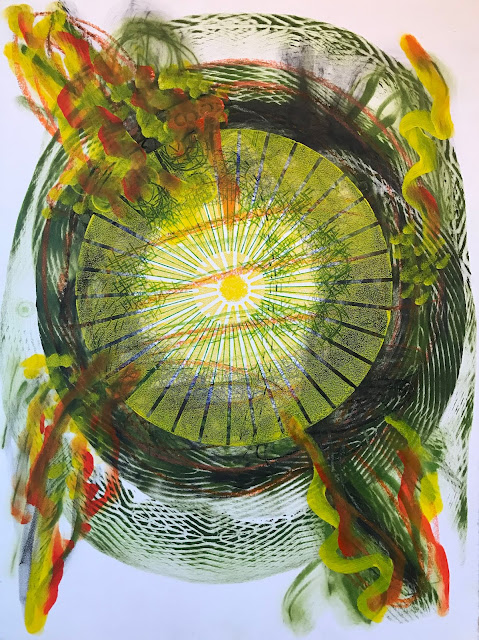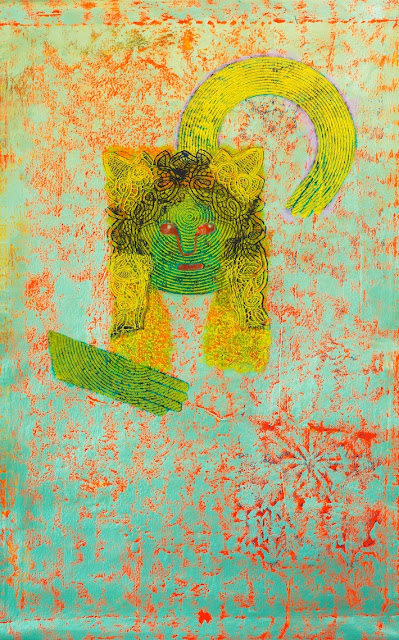Paintings for Finlandia University
http://www.finlandia.edu/news/finlandia-university-gallery-announces-holiday-hours/
FERRY CROSS THE RIVER No. 1 ( EMIGRANT )
/ LAUTTA YLI JOEN No. 1 ( SIIRTOLAINEN )
2017 oil on canvas 214 X 152 cm / 84 X 60 in
The culminating runo of the Kalevala tells of the maiden Marjatta, who becomes pregnant after eating a berry --in Finnish, marja-- and gives birth to a baby boy. Wise hero Väinämöinen condemns the child to death. The baby speaks and adjudges Väinämöinen to be an unrighteous demigod. Following this, the baby is baptized and named King of Karjala. Defeated, Väinämöinen goes to the shores of the sea, where he sings into existence a copper boat, with which he sails away from the mortal realms.
The whirlpool of baby faces circling the sage's head alludes to the root of Väinämöinen's name-- archaic Finnish väinä, deep stream pool. The ring of faces is like the halo of twittering birds that accompany a cartoon character who is reeling from having been hit in the head. Väinämöinen's diamond plate-patterned head ( alluding to the temporal distance between the ages of copper and steel ) on its crescent-moon neck is a trope I often use: the kind of extreme perspective that came about when 20th century animated cartoons freed themselves from naturalism and exploited imaginary cartoon physics. A character's head can zoom a mile from its body on an elongated neck to fill up the entire field of vision in close-up. In this way, the flatness of the picture plane is given extreme depth while playing fair with its two-dimensionality.
The ship, even before the painting insisted on the Väinämöinen theme, implied a portrait of a self --though not a self-portrait-- but rather a sort of Vitruvian Everyone, the self as a ship on various levels: the leathery hull and voltaic lower deck as the vegetative physical body, the bipartite superstructure as the dynamic senses and the psychological inner life, the vapourous smokestack as one's presence among others. Väinämöinen's head pops out from his emotional forecastle in an elastic paroxysm as if momentarily freed from himself.
The number 730 on the hull is a reminder that Väinämöinen was in his mother Ilmatar's womb for seven hundred and thirty years, while she was floating in the sea as the earth was formed.
WHISKER / VIHTAJA
2017 oil on canvas 198 X 147 cm / 78 X 58 in
The large figure with the vihta is derived from Max von Sydow in the sauna in Ingmar Bergman's 1960 film 'The Virgin Spring'. The figure being whisked is an example of how a last-minute decision can become a painting-idea, a statement that exists solely and specifically in the terms of how painting thinks and speaks. The arms demanded to stem directly from the figure's head to particularize the character's compliant, forbearing attitude. Arms emerging from ears also condenses the idea of paying attention, knowing, with potential energy, action. This is in keeping with what is for me a staple palette of black and yellow: the colour of bees, a token for night and day, an emblem of oscillating repose and energy.
TKO ( ULYSSES AND DIOMEDES )
/ TEKNINEN TYRMÄYS ( ULYSSES JA DIOMEDES )
2017 oil on canvas 198 X 147 cm / 78 X 58 in
The model is 'Dempsey and Firpo', 1923-24, by George Bellows, filtered through R.B. Kitaj's 1992 reworking 'Whistler vs. Ruskin (Novella in Terre Verte, Yellow and Red)', in which Kitaj presents Whistler's 1877 libel suit against Ruskin in terms of both a famous boxing match and a famous boxing painting. Kitaj designates the painting as a novella, the kind of melodrama that would have excited Victorians. By simultaneously drawing attention to the colours, Kitaj appears to side with Whistler and the purely aesthetic gaze.
The irony of the ruinous squabble is that both men were essentially on the side of an emerging Modernism. Their essential differences have not died out. Whistler was breaking ground for technical freedoms for painting which would evolve exponentially into abstract art. Ruskin objected, on political-economic principles, to the inflamed capitalization and fashion-consumption of art, seeing a symptom of this in Whistler's prices.
In the Dantean realm, Ulysses and Diomedes share a joint punishment, damned for trickery, Ruskin's charge against Whistler. Ulysses, like Whistler, represents an immensely gifted individual not afraid to exceed established limits and chart new ground. His TKO has not only knocked his opponent out of the ring, but into a different visual register, from decorative stylization to coarse naturalism. Like Väinämöinen in the 'Emigrant' picture, the figure ruptures the fourth wall of the painting by a sudden code-switching. I've never seen especial virtue in a strictly stylistically unified surface. One of the freedoms that the 20th century has bequeathed to painting is that it isn't necessary to continue the way one has begun. To do that is to risk falling asleep, and painting, if it is anything, is a testimony of wakefulness in the service of conjuring dream.
I followed Kitaj's lead in basing the upended torso of the bottom figure on the figure of Rembrandt's Christ in the Munich 'Descent from the Cross', in the Alte Pinakothek, which I saw in 2015. The painting coincided with my reading of Frederic Jameson's essay on the dramatic meanings of the Deposition in Baroque painting.
POET IN EXILE / RUNOILIJA MAANPAOSSA
2017 oil on canvas 200.5 X 147 cm / 79 X 58 in
A sleeping figure at the bottom, attended by dreams, a figure struggling to stay awake at the top, a string of night walkers on a rainy 4 AM in Eliot's Unreal City.
INFERNO: CANTO I
2017 oil on canvas 200.5 X 147 cm / 79 X 58 in
Dante homesick for Florence, the Arno shrunken in dreams to a small fishing village, as dreams do. He whisks himself with a vihta of words --the motif is described below in 'Sauna: Word Hoard'. Beatrice at this point is a face in the wood grain. Virgil suddenly appears in the form of Al Jolson in full-throated song.
PAOLO AND FRANCESCA
2017 oil on canvas 200.5 X 147 cm / 79 X 58 in
The story of Paolo and Francesca, trapped together in an eternal whirlwind, causes Dante to faint out of pity, or perhaps, because this is one of the several times Dante the Poet intrudes on his narrative of Dante the Pilgrim: Francesca shifts the blame for their sin and damnation on the kind of love poetry with which Dante established his reputation as a writer.
The golden form around the barrel-cauldron is the tail of King Minos, the Judge of the Damned, the second boss encountered in the Inferno. He judges the souls and tells them on what Circle of Hell will the soul go by wrapping his tail around his body a certain times-- a cartoonish image. The Pilgrim's faint is rendered in the standard archaic ( Modernism is our Antiquity ) cartoon code: stiff-legged, anti-gravity kinesics, indebted to Philip Guston.
SAUNA: WORD HOARD
2017 oil on canvas 200.5 X 147 cm / 79 X 58 in
The monochromatic form near the centre of the picture is a Rococo sigil containing all the letters of the alphabet strung together as a decorative glyph. This is a motif I've used often to indicate language as a system, or specifically, of parole in its sense of rhetorical voluptuousness, speech as convoluted and demanding of unriddling as the design itself. This kind of speech usually takes the form of poetry, and therefore of the structure of the dreaming mind: condensation, metaphor, displacement, and metonymy.
The sauna demands an etiquette of reserve, but this is not the same as silence. The figures here are conversing in what is tantamount to haiku. The term 'word hoard' implies reticence as much as it does stockpile.
RIGHTEOUS PAGANS IN LIMBO / HYVEELLINEN PAKANAT LIMBOOSSA
2017 oil on canvas 155 X 141 cm / 61 X 55.5 in
In Canto IV Dante recounts his meeting with the virtuous pagans-- Horace, Homer, Ovid, Lucan, Socrates, Plato, Cicero, Seneca, Aristotle, and Virgil himself, among many others-- in the first circle of Hell as a field day as ineffable as his account of Paradise.
This canto is one of the moments where again Dante the Poet intrudes on his narrative of Dante the Pilgrim. His forefathers in thought and poetry invite him into their circle. In a show of self-reflexivity on Dante's part he places himself among the great classical poets, suggesting that he is one as well. Hence, his satisfied sauna pose, belly filled with the Rococo alphabet sigil.
FIERY FURNACE / TULINEN UUNI
2017 oil on canvas 160 X 142 cm / 63 X 56 in
This appears to be as much Shadrach, Meshach, and Abednego, as anything in Dante. A painting follows its own logic. Two of the characters have faces moulting to reveal new heads composed of sunlit and moonlit landscapes, in a parody of Renaissance alchemical pictures, filtered through Douglas Harding's idea of "the headless way".
ABANDON HOPE ( IT BROUGHT YOU HERE )
/ LUOPUA TOIVOSTA ( SE TOI SINUT TÄNNE )
2017 oil on canvas 154 X 142 cm / 60.5 X 56 in
The idea for this painting of the Gates of Hell comes from Clive James's exciting 2012 translation in quatrains, which rewrites the verse in words that are not to be found in Dante. It's inaccurate but not inapposite. It sends Dante north with a sense of fate reflective of northern European verse, closer to Beowulf than Ovid.
The hanged man figure bearing the motto, scrawled on blackboard paint, alludes to the pittura infamante, the image of a man hanging upside-down by one ankle, an Italian punishment for traitors, but equally a depiction of the Norse god Odin, who hung for nine days from the world-tree Yggdrasil in order to gain knowledge. The story is a clear parallel with the Crucifixion.
Dante:
Dinanzi a me non fuor cose create
se non etterne, e io etterno duro.
Lasciate ogne speranza, voi ch’intrate’.
Allen Mandlebaum, 1982:
"Before me nothing but eternal things
were made, and I endure eternally.
Abandon every hope, all who enter here."
Robert Pinsky, 1994:
"Before me not eternal; eternal I remain.
Abandon all hope, you who enter here."
Clive James, 2012:
"From now on, every day feels like your last
forever. Let that be your greatest fear.
Your future now is to regret the past.
Forget your hopes. They were what brought you here."
in Finnish, after James:
Tästä lähtien, joka päivä tuntuu kuin viimeinen
ikuisesti. Anna sun se olla suurin pelko.
Tulevaisuutesi on nyt pahoillani menneisyydestä.
Toivot luopua. He toi sut tänne.
Eino Leino, 1912-14:
Mua ennen luotua ei ollut mitään,
iäistä vain, myös itse kestän iki:
ken tästä käy, saa kaiken toivon heittää.
There was nothing there before I was created,
everlasting alone, I too will endure forever.
When you come by here, you can abandon hope.
DANTE AND VIRGIL
2017 oil on canvas 160 X 142 cm / 63 X 56 in
Tiptoeing downwards past the three beasts, with the grid-mountain of Purgatory in the middle distance, and the Empyrean behind. Reducing the walking figure to an X with eyes floating ahead is my most minimal figure rendering. This painting doesn't go as far. These go a bit further:
TAROT ZERO
2013 oil on paper 61 X 45 cm / 24 X 18 in
FREEBIRD
2017 oil on paper 61 X 45 cm / 24 X 18 in
PURGATORIO NO. 2
2016 oil on canvas 132 X 122 cm / 52 X 48.5 in
This is like a poster for Aki Kaurismäki's remake of Ingmar Bergman's 'Virgin Spring', something I'd like to see.
WAITING FOR LEMMINKÄINEN / LEMMINKÄISEN VASTAUS
2017 oil on canvas 160 X 42 cm / 63 X 56 in
Max Ernst made drip paintings from 1942 by swinging a paint can with a hole punched in the bottom like a pendulum over the canvas. I use the technique here in a Kalevala painting to make what amounts to indexical marks alluding to the maidens of the island, walking the floor back and forth, waiting for the romantic hero. Here he's a pockmarked boy, bathing in a lake outside the sauna, with its benches and hot rocks, and green aromatic löyly rising up in the ghost-shapes of burning wood, lignum + ignis entwined.
STEAM-GIVER / LÖYLYJÄ No 1
2017 oil on canvas 132 X 120.5 cm / 52 X 47.5 in
There is a suggestion here of an army tent sauna, with soldiers.
STEAM-GIVER / LÖYLYJÄ No 2
2017 oil on canvas 137 X 94 cm / 54 X 37 in
The löylyjä's innards' --their sisäpuoli, their sisu-- is here the alphabet glyph from the painting 'Sauna: Word Hoard', suggesting a bardic figure composing and singing while tending the sauna. I suspect the bright blue water is the melody, recalling Sibelius calling his sixth symphony "cold spring water" in opposition to many contemporary "cocktails".
MADONNA
2017 oil on canvas 137 X 94 cm / 54 X 37 in
The three figure studies 'Löylyjä No.2', 'Purgatorio No. 3', and this 'Madonna' all share the runo-torso.
PURGATORIO NO. 3
2017 oil on canvas 137 X 94 cm / 54 X 37 in
The three figure studies 'Löylyjä No.2', 'Purgatorio No. 3', and this 'Madonna' all share the runo-torso.
HAIR WASHING / HIUSTEN PESU
2017 oil on canvas 132 X 124.5 cm / 52 X 49 in
In Joensuu, my wife Paula and my cousin Alan's wife Anu interacted as best they could, neither speaking the other's language. But they became sauna friends, washing one anothers' hair, and bonding over sewing techniques.
AINO SWIMMING / AINO UI
2017 oil on canvas 135 X 82.5 cm / 53 X 32.5 in
INFERNO: CANTO VIII
2017 oil on canvas 138.5 X 147 cm / 54.5 X 28 in
Virgil's kiss of praise for Dante on the latter's condemnation of his Florentine enemy Fillipo Argenti, swimming in the marsh of the Wrathful.
SHAVER / PARRAN AJAJA
2017 oil on canvas 89 X 69 cm / 35 X 27 in
Series of figures with a mirror.
NIGHT OUT / ILLANVIETTOON
2017 oil on canvas 89 X 69 cm / 35 X 27 in
MOVING THE MIRROR / PEILIN SIIRTO
2017 oil on canvas 89 X 69 cm / 35 X 27 in
At some point in the production of a series or stream of paintings, there is an eruption of an attitude from the future, a kind of demand to change horses. Here, after many fundamentally lean, graphic paintings, is a reminder of the pleasures of thick, reckless paint and a return to strictly painterly facture. The surface goes from raw canvas and automotive spray paint to clotted oil-stick impasto.
RED WHISKER / PUNAINEN VIHTAJA
2017 oil on canvas 91.5 X 84 cm / 36 X 33 in
STEAM / LÖYLY
2017 oil on canvas 133 X 50 cm / 52.5 X 19.5 in
detail:
FERRY CROSS THE RIVER No. 1 ( EMIGRANT ) / LAUTTA YLI JOEN No. 1 ( SIIRTOLAINEN )
2017 oil on canvas 214 X 152 cm / 84 X 60 in
detail:
DANTE AND VIRGIL
2017 oil on canvas 160 X 142 cm / 63 X 56 in
detail: DANTE AND VIRGIL
2017 oil on canvas 160 X 142 cm / 63 X 56 in































































